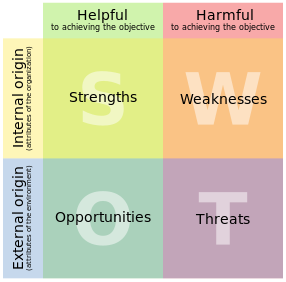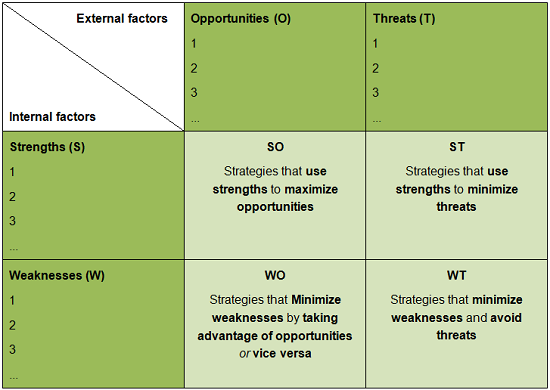SWOT analysis
This article will discuss two different applications of SWOT analysis - the "conventional" and a variant called the TOWS Matrix, which utilises the inventory of SWOTs in a more systematic way than the conventional.
Contents |
Introduction
The SWOT analysis is a tool that provides a basic framework for situation analysis. It generates lists or inventories of strengths, weaknesses, opportunities and threats which can be used when generating strategies. [2] The strengths and weaknesses are internal factors representing the present environment of a system. The opportunities and threats are external factors which have the potential to influence a system in the future. The factors are universal which makes the SWOT analysis applicable in many organisational contexts like businesses or projects.
There is no single guide or manual on how to perform a SWOT analysis - on the contrary many papers, books and articles have been issued describing, criticising and elaborating on the applications of the SWOT analysis [3]. The criticism is often based upon the fact that it has a simple structure and does therefore, in itself, not provide a rigorous framework that ensures reliable inputs to strategic planing. An analysis can thus, if not carefully conducted, consist of poorly structured inventories containing very general or vaguely formulated factors that are inconsistent and hard to verify [2].
The history of SWOT
Although there is no single inventor/author of the SWOT analysis, early versions are developed in Harvard Business School by George Albert Smith Jr. and C Roland Christiensen in the 1950s and 1960s [4]. The four factors that later became the Strengths, Weaknesses, Opportunities and Threats (SWOTs) were then called "opportunities" "risks" "environment" "problems of other industries". Another version was developed at Stanford University by Albert Humphrey which was based upon factors we know as SWOT today. The factors, represented by the acronym SOFT, were then: “What is good in the present is SATISFACTORY, good in the future is an OPPORTUNITY; bad in the present is a FAULT and bad in the future is a THREAT.” [5]
Different applications of SWOT analysis
The conventional SWOT analysis is usually presented in a 2X2 matrix which generates four boxes of inventories - one for strengths, one for weaknesses, one for opportunities and one for threats, see figure 1 [6]
Figure 1
The analysis can be carried out in three steps [5]:
Step 1 Gather information about the present. These are the helpful strengths and the harmful weaknesses.
Step 2 Think of what might be in the future. These are the helpful opportunities and the harmfulthreats.
Step 3 Review the SWOT matrix with the aim of creating an action plan that involves the four areas like this:
Strengths - need to be maintained, built upon or leveraged
Weaknesses - need to be remedied, changed or stopped
Opportunities - need to be prioritized, captured, built on and optimized
Threats - need to be countered or minimized and managed
The TOWS Matrix
The tows matrix is a framework that facilitates a systematic analysis by matching the external opportunities and threats with the internal strengths and weaknesses of an organisation [7].
Like the SWOT analysis, the TOWS Matrix is, like the name clearly suggests, also presented in a matrix. The matrix in figure 3 (drawn with inspiration from [8]) contains, like the SWOT analysis, four boxes where the SWOTs are listed. There are however furthermore four boxes which are used for developing concrete strategies derived from matching the external factors with the internal factors. The four examples given here come from a TOWS Matrix applied to Volkswagen (VW) in the 1970's. [7]
- ST - Strategies that use strengths to minimize threats. Due to a devaluation of the Dollar in relation to the Deutsche Mark, the exchange rate rose thus increasing the prices for the VW's American buyers. This gave other car manufacturers an competitive advantage. VW were strong in R&D and engineering as well having strong automation capabilities and therefore an efficient production. This meant that VW could cope with the unfavourable exchange rate and the their competitors by building an assembly plant in U.S.
- WO - Strategies that Minimize weaknesses by taking advantage of opportunities or vice versa VW also faced the threat of rising salary costs in Germany. Attractive offers were given to build an assembly plant in U.S. which presented an opportunity VW could take advantage of.
- SO - Strategies that use strengths to maximize opportunities. VW were still strong in R&D and engineering as well having an efficient production. This combined with attractive offers to build an assembly plant in U.S. pointed towards
Figure 3
Internal factors
The strengths and weaknesses are, as mentioned, not only factors regarding the present, they are also to be found within the project subject to the SWOT analysis. This means that the internal factors are all factors that the project is in control of. Often the internal factors can be found within these general areas: [9]
Human resources - e.g. staff, volunteers and leaders
Physical resources - e.g. production facilities and equipment
Activities and processes - e.g. programs and systems you employ
Past experiences
External factors
Corresponding to the internal factors are the opportunities and threats not only factors regarding the future, they are also to be found outside the project subject to the SWOT analysis. The external factors can be found within the areas which are considered in the analysis tools Porter's Five Forces and PESTEL.
Obtaining adequate and truthful information
Stake holders on all levels of the project coalition.
Setting the objective
The SWOTs are relative to the objective. For example having an expert in tropic building technology on the project team is an irrelevant strength if the building is to build in the Arctic.
Prioritising the SWOTS
updating the SWOT inventory
References
- ↑ [link/title] Name of link
- ↑ 2.0 2.1 [SWOT does not have to be recalled - it needs to be enhanced] http://www.westga.edu/~bquest/2000/swot1.html
- ↑ [Sepehr Ghazinoory , Mansoureh Abdi & Mandana Azadegan-Mehr (2011) Swot Methodology: A State-of-the-Art Review for the Past, A Framework for the Future, Journal of Business Economics and Management, 12:1, 24-48, DOI: 10.3846/16111699.2011.555358] http://dx.doi.org/10.3846/16111699.2011.555358
- ↑ [History of SWOT Analysis] http://www.marketingteacher.com/history-of-swot-analysis/
- ↑ 5.0 5.1 [SWOT analysis (TOWS matrix) Made Simple] https://rapidbi.com/swotanalysis/
- ↑ [A SWOT analysis, with its four elements in a 2×2 matrix.] http://en.wikipedia.org/wiki/SWOT_analysis
- ↑ 7.0 7.1 [Heinz Weihrich - The TOWS Matrix --- A Tool for Situational Analysis] http://www.usfca.edu/fac_staff/weihrichh/docs/tows.pdf
- ↑ [Using the TOWS Matrix Developing Strategic Options From an External-Internal Analysis] http://www.mindtools.com/pages/article/newSTR_89.htm
- ↑ [Assessing Community Needs and Resources » Section 14. SWOT Analysis: Strengths, Weaknesses, Opportunities, and Threats] http://ctb.ku.edu/en/table-of-contents/assessment/assessing-community-needs-and-resources/swot-analysis/main

